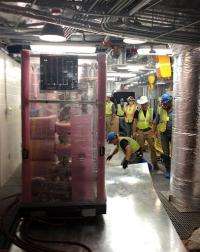World's most sensitive dark matter detector set up

The world's most sensitive dark matter detector settled into a new home Friday in an old U.S. gold mine.
And when it starts collecting data later this year, scientists say it could lead to another breakthrough in studies of the universe, on the scale of the recent celebration over the so-called "God particle."
"Dark matter presents a much bigger problem to detect," said Tom Shutt, a physics professor with Case Western Reserve University who's working on the Large Underground Xenon detector, known as LUX.
"If we find it, it's going to be a much bigger shift in our understanding of physics."
Scientists earlier this month announced a breakthrough in the existence of the Higgs boson, a subatomic particle that scientists believe gives other particles mass. It is sometimes called the "God particle" because its existence is key to understanding the early evolution of the universe.
Dark matter, meanwhile, is elusive matter that scientists believe makes up about 25 percent of the universe. They know it's there by its gravitational pull, but unlike regular matter and antimatter, it's so far undetectable.
By discovering dark matter, scientists could explain why the universe isn't made up equally of matter and antimatter. That, in turn, could explain how the world as we know it came to be.
The Sanford Underground Research Facility was unveiled in May within a closed gold mine in South Dakota's Black Hills.
The mine is useful because dark matter is too sensitive to detect in normal laboratories. By setting up LUX deep underground, dark matter should be shielded from pesky cosmic radiation that interferes with detection.
Moving the three-ton detector into place took time and care. It was wrapped in protective foam and plastic and rode part of the way underground on air bearings to protect it from even the slightest jiggle.
"It was a bit of a nail-biter," Yale Physics Professor Dan McKinsey said. "We always worry there might be something you didn't think of that could go wrong."
The detector could begin collecting data as early as December.
"We're all going after the same thing: We're trying to figure out what are the basic components of the universe," Shutt said.
Copyright 2012 The Associated Press. All rights reserved. This material may not be published, broadcast, rewritten or redistributed.

















